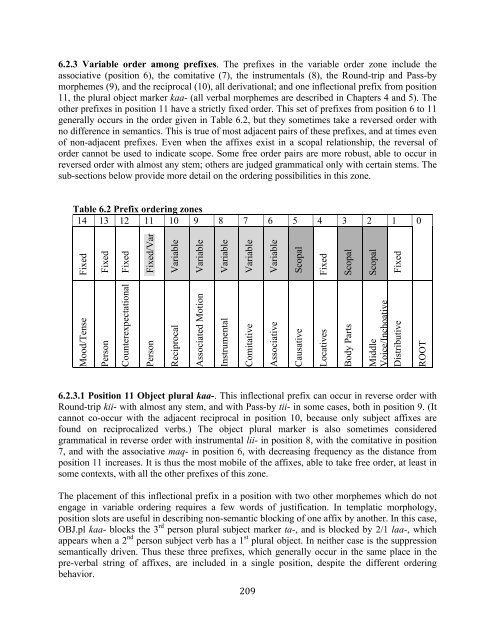The phonology and morphology of Filomeno Mata Totonac
The phonology and morphology of Filomeno Mata Totonac
The phonology and morphology of Filomeno Mata Totonac
You also want an ePaper? Increase the reach of your titles
YUMPU automatically turns print PDFs into web optimized ePapers that Google loves.
6.2.3 Variable order among prefixes. <strong>The</strong> prefixes in the variable order zone include the<br />
associative (position 6), the comitative (7), the instrumentals (8), the Round-trip <strong>and</strong> Pass-by<br />
morphemes (9), <strong>and</strong> the reciprocal (10), all derivational; <strong>and</strong> one inflectional prefix from position<br />
11, the plural object marker kaa- (all verbal morphemes are described in Chapters 4 <strong>and</strong> 5). <strong>The</strong><br />
other prefixes in position 11 have a strictly fixed order. This set <strong>of</strong> prefixes from position 6 to 11<br />
generally occurs in the order given in Table 6.2, but they sometimes take a reversed order with<br />
no difference in semantics. This is true <strong>of</strong> most adjacent pairs <strong>of</strong> these prefixes, <strong>and</strong> at times even<br />
<strong>of</strong> non-adjacent prefixes. Even when the affixes exist in a scopal relationship, the reversal <strong>of</strong><br />
order cannot be used to indicate scope. Some free order pairs are more robust, able to occur in<br />
reversed order with almost any stem; others are judged grammatical only with certain stems. <strong>The</strong><br />
sub-sections below provide more detail on the ordering possibilities in this zone.<br />
Table 6.2 Prefix ordering zones<br />
14 13 12 11 10 9 8 7 6 5 4 3 2 1 0<br />
Fixed<br />
Mood/Tense<br />
Fixed<br />
Person<br />
Fixed<br />
Counterexpectational<br />
Fixed/Var<br />
Person<br />
Variable<br />
Reciprocal<br />
Variable<br />
Associated Motion<br />
Variable<br />
Instrumental<br />
Variable<br />
Comitative<br />
! #.-!<br />
Variable<br />
Associative<br />
Scopal<br />
Causative<br />
Fixed<br />
Locatives<br />
Scopal<br />
Body Parts<br />
Scopal<br />
Fixed<br />
Middle<br />
Voice/Inchoative<br />
Distributive<br />
6.2.3.1 Position 11 Object plural kaa-. This inflectional prefix can occur in reverse order with<br />
Round-trip kii- with almost any stem, <strong>and</strong> with Pass-by tii- in some cases, both in position 9. (It<br />
cannot co-occur with the adjacent reciprocal in position 10, because only subject affixes are<br />
found on reciprocalized verbs.) <strong>The</strong> object plural marker is also sometimes considered<br />
grammatical in reverse order with instrumental lii- in position 8, with the comitative in position<br />
7, <strong>and</strong> with the associative maq- in position 6, with decreasing frequency as the distance from<br />
position 11 increases. It is thus the most mobile <strong>of</strong> the affixes, able to take free order, at least in<br />
some contexts, with all the other prefixes <strong>of</strong> this zone.<br />
<strong>The</strong> placement <strong>of</strong> this inflectional prefix in a position with two other morphemes which do not<br />
engage in variable ordering requires a few words <strong>of</strong> justification. In templatic <strong>morphology</strong>,<br />
position slots are useful in describing non-semantic blocking <strong>of</strong> one affix by another. In this case,<br />
OBJ.pl kaa- blocks the 3 rd person plural subject marker ta-, <strong>and</strong> is blocked by 2/1 laa-, which<br />
appears when a 2 nd person subject verb has a 1 st plural object. In neither case is the suppression<br />
semantically driven. Thus these three prefixes, which generally occur in the same place in the<br />
pre-verbal string <strong>of</strong> affixes, are included in a single position, despite the different ordering<br />
behavior.<br />
ROOT

















